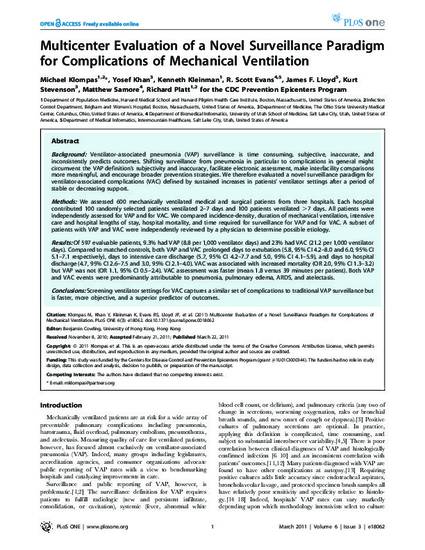
BACKGROUND:
Ventilator-associated pneumonia (VAP) surveillance is time consuming, subjective, inaccurate, and inconsistently predicts outcomes. Shifting surveillance from pneumonia in particular to complications in general might circumvent the VAP definition's subjectivity and inaccuracy, facilitate electronic assessment, make interfacility comparisons more meaningful, and encourage broader prevention strategies. We therefore evaluated a novel surveillance paradigm for ventilator-associated complications (VAC) defined by sustained increases in patients' ventilator settings after a period of stable or decreasing support. METHODS:
We assessed 600 mechanically ventilated medical and surgical patients from three hospitals. Each hospital contributed 100 randomly selected patients ventilated 2-7 days and 100 patients ventilated >7 days. All patients were independently assessed for VAP and for VAC. We compared incidence-density, duration of mechanical ventilation, intensive care and hospital lengths of stay, hospital mortality, and time required for surveillance for VAP and for VAC. A subset of patients with VAP and VAC were independently reviewed by a physician to determine possible etiology. RESULTS:
Of 597 evaluable patients, 9.3% had VAP (8.8 per 1,000 ventilator days) and 23% had VAC (21.2 per 1,000 ventilator days). Compared to matched controls, both VAP and VAC prolonged days to extubation (5.8, 95% CI 4.2-8.0 and 6.0, 95% CI 5.1-7.1 respectively), days to intensive care discharge (5.7, 95% CI 4.2-7.7 and 5.0, 95% CI 4.1-5.9), and days to hospital discharge (4.7, 95% CI 2.6-7.5 and 3.0, 95% CI 2.1-4.0). VAC was associated with increased mortality (OR 2.0, 95% CI 1.3-3.2) but VAP was not (OR 1.1, 95% CI 0.5-2.4). VAC assessment was faster (mean 1.8 versus 39 minutes per patient). Both VAP and VAC events were predominantly attributable to pneumonia, pulmonary edema, ARDS, and atelectasis. CONCLUSIONS:
Screening ventilator settings for VAC captures a similar set of complications to traditional VAP surveillance but is faster, more objective, and a superior predictor of outcomes.
Available at: http://works.bepress.com/kenneth-kleinman/31/
